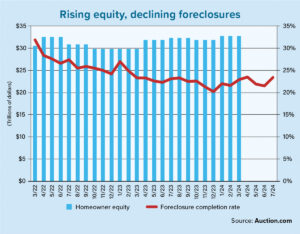With a predicted shift away from refinancing toward purchase mortgage lending for the remainder of 2021, lenders and servicing companies are placing more emphasis on mitigating portfolio runoff and better understanding the needs of prospective borrowers. Portfolio runoff — when outstanding debt is paid off without a corresponding increase in new loan volume — has emerged as a significant strategic consideration.
As interest rates begin to creep higher, and as refinance volumes begin to subside, many lenders are starting to evaluate the impact of this churn on their existing portfolios. What many are finding is that too much attention was paid to simply managing the recent surge of refinances and too little was directed toward managing the overall health of their books of business.
Today, what lenders and servicers require is the ability to proactively assess the loans in their portfolios to identify areas of vulnerability and opportunity, such as high credit-score borrowers with higher interest rates on existing loans. This requires a better understanding of borrowers’ needs as well as the possible dynamics at play that could lead existing clients to look elsewhere for a new loan. These insights enable lenders and the mortgage originators who work with them to more intelligently adjust their retention and prospecting strategies to gain a competitive advantage in the marketplace — for both existing and potential clients.
Competitive insights
With the proper data and insights, lenders can more effectively understand who the borrower is and which loan products will best satisfy their individual needs. Having a full view of the borrower enables lenders to provide a higher level of client service as information about a borrower’s age range, generation band, credit score and even geographic location helps to better identify which loan type, term and rate is the most appropriate fit for their circumstances. All of this can increase client satisfaction and loyalty.
Too often, lenders purchase lists of leads to market their loan products to but then have a difficult time determining why certain preapproved prospects did not ultimately close a loan with them. Deeper insights can give mortgage lenders and originators visibility into where a lost prospect closed his or her loan, as well as the key characteristics of the successfully closed loan.
Having this level of insight about the market helps a lender to adjust their strategies and offerings appropriately. This is especially true for consumers who had loans approved through your company but wound up closing with a competitor.
Lenders that do not work to better understand consumer behavior will lack the knowledge, tools and resources required to make necessary refinements to existing retention strategies, and they will lack the information necessary for a competitive advantage with current clients and prospects. They will be less equipped to make informed, growth-driving decisions.
Surprisingly, many lenders lack an understanding of exactly how much early payoffs are actually costing them in today’s market. As rates begin to go up and housing inventory remains low, however, portfolio monitoring will be more important as there will be fewer new originations for lenders to compete for. In fact, according to the Mortgage Bankers Association, refinance applications decreased by 5% from the previous week in one snapshot late this past March.
Adjusted strategies
Although it sounds simple in theory, the reality is that it can be challenging for lenders to easily develop new decision strategies — and to successfully and quickly deploy them. Too often, this is a disconnected, complicated and time-consuming process. With unified analytics, combined with the execution of loan-level competitive intelligence and decisionmaking, lenders and the originators who work with them can adjust strategies to better align with growth objectives and influence multiple business areas including:
- Portfolio runoff. With the ability to identify runoff trends and strategies, client retention is improved. Having insights (such as knowing whether a borrower has sold a home or refinanced with a different lender, and if so, which lender) helps drive understanding of who business is being lost to. Additionally, lenders can determine which products they could or should have offered to retain their current portfolio and increase client satisfaction.
- Pipeline attrition and new business. Fallout assessment improves closing rates. Greater insights help lenders uncover whether a prospect obtained a loan with another lender. Data also tells them if the prospect ultimately ended up with a different loan product or if the time to close was too long, and it identifies the borrower groups and credit bands being lost.
- Marketing spend. Seeing trends in age bands, generational activity and risk tolerance helps lenders to more clearly understand whether their marketing expenses are in fact targeted to the right prospect. Insights into whether a lead obtained a new mortgage; the actions the prospects took; which lender the lead ultimately chose; whether they are still a viable lead; and whether they fit the target audience helps to ensure that marketing initiatives are effective and the return on investment is maximized.
Today, lenders are tasked with simultaneously building healthy pipelines to grow their portfolios while working to protect the integrity of their existing portfolios from runoff. In a market characterized by having more real estate agents than homes for sale, lenders need to be able to recognize which prospects are closing successfully and quickly shift to maximize these opportunities. As the market evolves, lenders and originators who leverage data and analytics to help them refine and build more effective marketing and retention strategies are ultimately the ones who will thrive. ●
Author
-
Craig Crabtree is senior vice president and general manager of Equifax Mortgage and Housing, where he manages the company’s mortgage, rental and real estate industries across all solution and product categories. Since joining Equifax in 2010, Crabtree has expanded the capabilities that service these industries to include employment- and income-verification services, capital markets, and property and data analysis.





